Arts and Culture
 A 3,000-year-old Indian textile tradition finds new life in Brooklyn workshops.
A 3,000-year-old Indian textile tradition finds new life in Brooklyn workshops.
Published August 21, 2025
 Amrutha Kosuru
Amrutha Kosuru
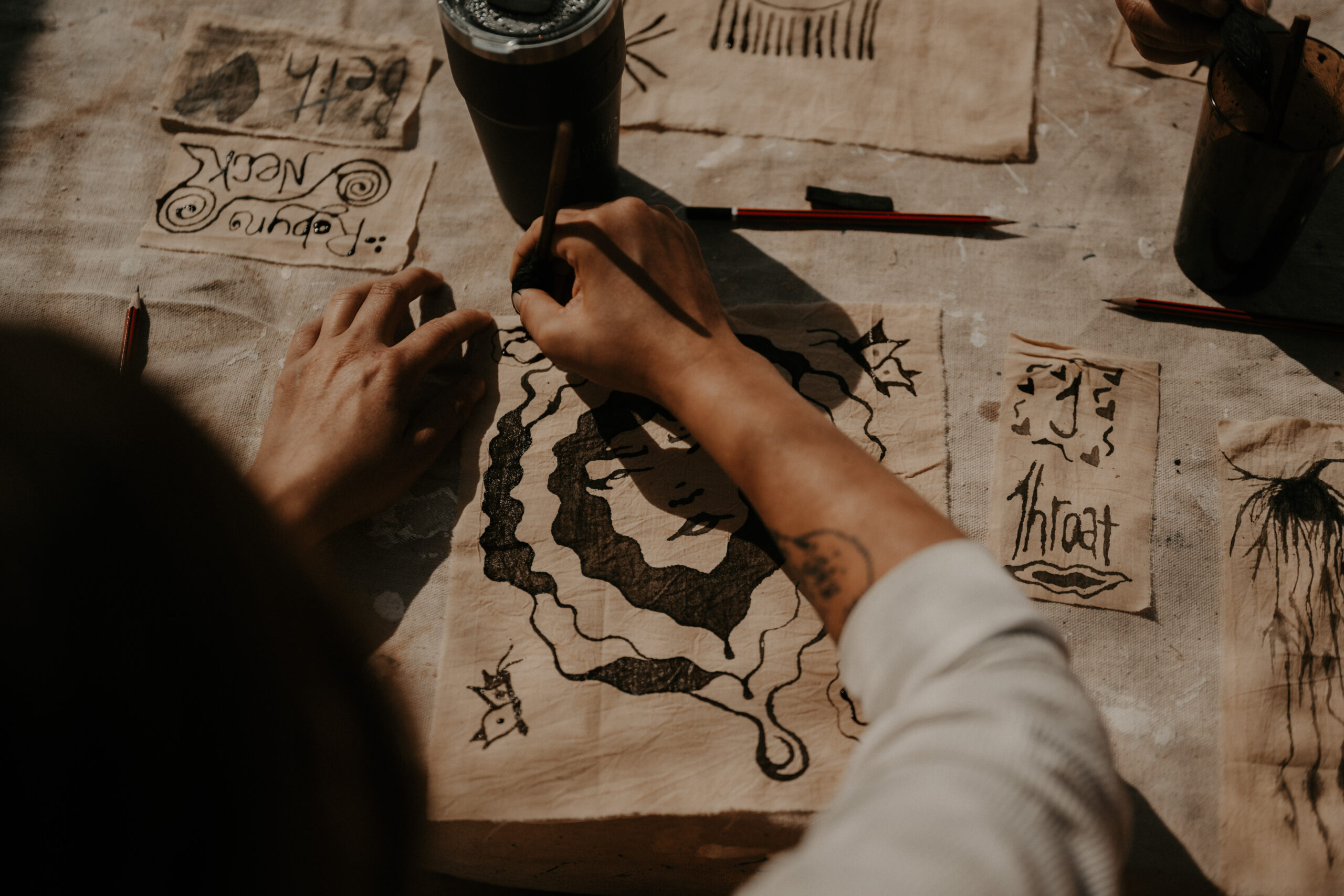
Kalamkari artist. (Photo courtesy of Nikita Shah.)
In a bright Brooklyn apartment, young professionals gather around a large wooden table, learning to work with natural dyes and the bamboo pens traditionally used in making kalamkari, an ancient artform from rural Andhra Pradesh in southeastern India. Artisans have practiced these techniques for generations in making tapestries and saris, yet kalamkari — literally “pen work” — has found new life in New York City, carried forward, in some cases, by people who had never been exposed to the culture around it before.
Artist Nikita Shah’s path to becoming a kalamkari teacher in New York began with her eight-year tenure as a designer with Gaurang Shah, a luxury brand based in India. Growing up in India, she had been surrounded by traditional crafts without fully appreciating them. “People didn’t like kalamkari as much as they do now,” she recalled.
One of her many works is a recent project called ‘At Home in Brooklyn.’ After months of kalamkari workshops held at the Brooklyn Community Pride Centre and GRIOT senior center, more than 30 participants created a communal kalamkari story cloth. Most of the participants in this project belonged to queer and other marginalized communities of New York. For Shah, this was a direct representation of the origins of kalamkari as a craft in India.
“It goes back to … pre-colonial, pre-Hindu temple patronage,” Shah explained. “There have been histories of kalamkari written by lower-class people, people who didn’t have a voice in society. I think about who the people are who don’t have a voice today, and how do we safeguard their stories.”
The artwork was showcased at Brooklyn Arts Council earlier this year.
“The practice of kalamkari storytelling hardly exists in India anymore,” Shah said, having spent over a decade with artisans and weavers in the country. The number of artisans who use kalamkari as a storytelling medium can be counted on her fingers, she said.
Ancient roots, spiritual purpose
Kalamkari’s roots date back over 3,000 years to ancient India, where this hand-painted and block-printed textile art first emerged in the villages or towns that were popularly known for the historic Hindu temples of Andhra Pradesh and Telangana. Initially, kalamkari served a deeply spiritual purpose, with artisans creating intricate narratives from Hindu epics on temple cloths and scrolls — sacred storytelling mediums that brought mythology to life.
Two distinct styles evolved: Srikalahasti, known for its freehand drawing with a kalam (bamboo pen), and Machilipatnam, a block-printing technique. In Pedana, a small town in the Machilipatnam District of Andhra Pradesh, kalamkari begins with handloomed cotton, which undergoes transformation through natural processes: soaking in groundwater, bleaching with plant dyes, resting overnight in small oval leaves from a fruit tree to help retain the colors, then boiling in copper vessels with roots and flowers.
Finding community in Brooklyn
Shah’s apartment doubles as her art studio and kalamkari portraits of all sizes fill the space. The dyes and cloth resemble the artform in India, but designs are different, personal, and modern. Some portraits are small, like one of the New York subway and the Statue of Liberty. Some are more intricate — a portrait of a female body with a deep mauve background.

Working with traditional materials in New York presents unique challenges. Shah sources her kalams (bamboo pens) and natural dyes directly from her mentor, Mamata Reddy — the founder of KalamCreations — in India, paying above market rate. “For anything I buy from them, I pay 1.5 times the price,” she explains. “They are custodians of a knowledge system that’s very rare.”
A significant portion of her job at the luxury brand Gaurang involved living with traditional weavers in various parts of India, observing them and occasionally assisting them with their weaving. It was through these homestays and immersive experiences that she began understanding the depth of knowledge embedded in these practices. “I learned not just the techniques but the traditions that go into textile making — knowledge that you’re not taught in design schools,” she said.
When Shah moved to New York in 2019 to pursue an Associate’s degree in apparel design at the Fashion Institute of Technology, she discovered something unexpected in conversations with family, friends, and fellow classmates: an audience hungry for the knowledge and experiences she carried.
“I realized there was a gap — someone who had this kind of knowledge and people who were interested in learning it,” she said. Shah finished her degree and began conducting small-scale workshops in her home studio, a choice made to reflect the space and atmosphere of weavers’ homes in India. “I really want to impart every aspect of weavers’ and artisans’ lives.”
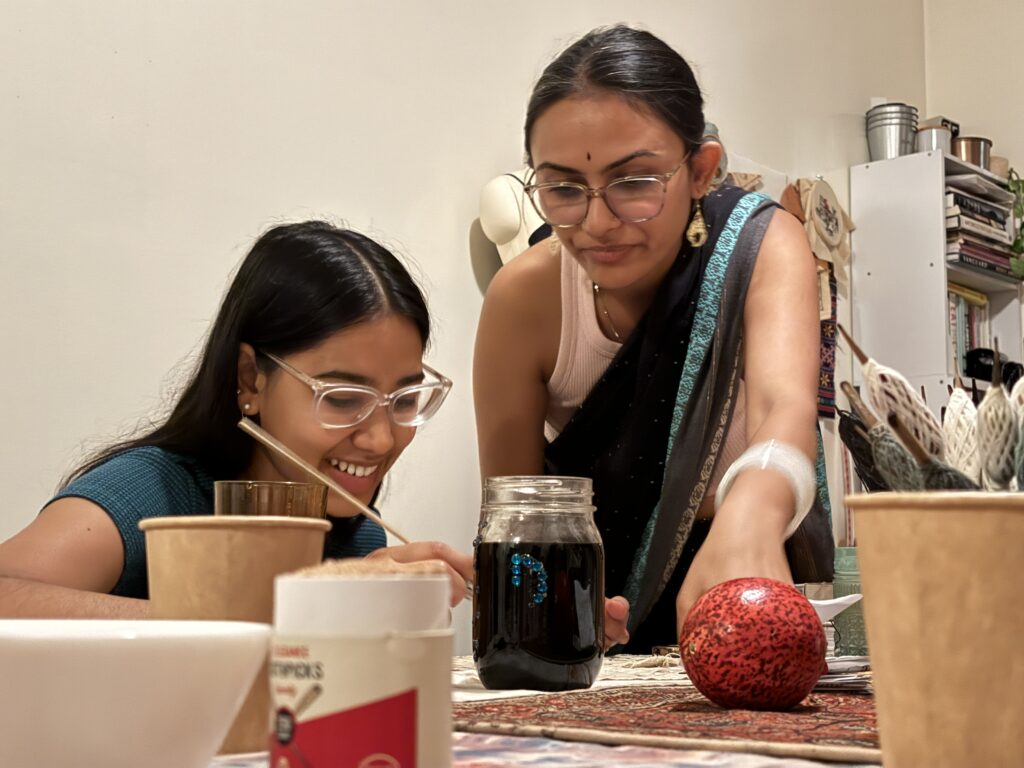
Shah saw the impact that the storytelling aspects of kalamkari had on attendees, and later curated a semester-based workshop series inspired by the concept of Fursat, a term used across South Asian languages to invoke leisure, reflection, and wisdom. Through Fursat, attendees not only learned textile techniques like kalamkari, alongside phulkari and kutchi work, different forms of embroideries and appliqué practiced in India, but formed communities.
Fursat workshops are intimate, with seven to eight people in each cohort. “It’s not a networking event,” Shah emphasized. “You’re here to build a connection.”
Sukanya Prasad, 26, a Brooklyn-based Tamil American who works as an education manager at a museum in Chelsea, was drawn to Shah’s workshops after moving to New York in 2020. “I was craving for more South Asian spaces,” she said.
“I think I have always had a particular interest in Indian textiles,” Prasad continued. “I’ve been learning how to crochet and embroider, and it was really exciting to see someone offering something that I knew I couldn’t get otherwise. I felt like if I wanted to learn about kalamkari, I had to go to India.”
For Shah, Fursat gives attendees “a way of knowing your heritage in a way that you don’t learn in school.”
Shah’s workshops examine the different modalities of its attendees as a means of uncovering their relationship to storytelling and the kalamkari art form. “I’m very type A,” said Bhavika Yendapalli, 21, noting that she struggled to relax and enjoy the process of artmaking rather than its end result. “My friends and I would find ourselves wanting to hang out and drink chai just like how our moms or grandmas did. We do see that as such a useful practice, of having that open-ended time.”
For participants, the approach offered something rare in their fast-paced lives. “I think the biggest thing was learning to slow down and also completely take away a timeline,” Yendapalli reflected. “Nikita would always kind of pull me back down. She would explain that this isn’t like another task that you need to do. It doesn’t need to be perfect. It doesn’t have to be finished right now.”
Shah begins her workshops, not on the cloth to be decorated, but at the coffee table. At least an hour at the beginning of each session is for discussing people’s lives. “You’re coming in and you’re showing up and you’re not starting on your piece right away,” Yendapalli explained. “We ease into it and then eat along the way. It really feels like another home.”
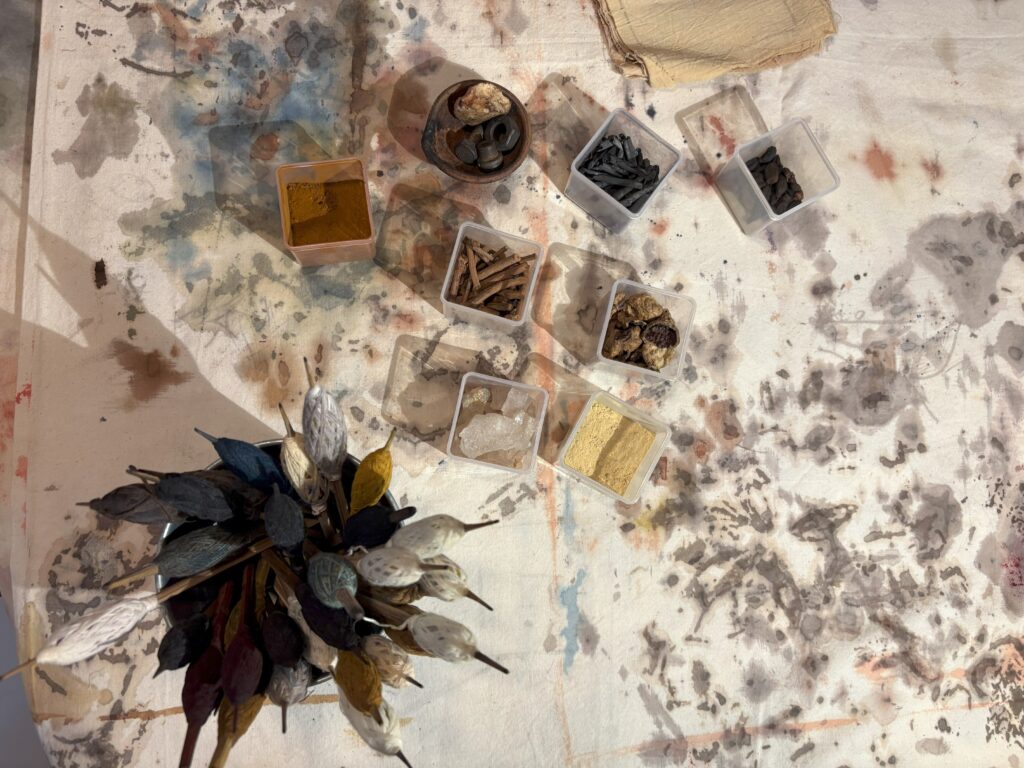
Classes are scheduled for a duration of three hours, but often extend much longer. “We would end up staying closer to almost midnight,” Prasad recalled. “Because there wasn’t really a structure to the class. We would just go with the flow, we would spend time just talking in the beginning, then we’d start working on the piece we had started and in the middle. We would have breaks, have some food. Nikita would always cook for us.”
For Prasad, this unhurried approach was transformative: “I really felt like it was a very grounding way to end my week. If I had a stressful week from work, especially, and this was a way for me to kind of wind down and just dissociate from that and really focus on the space that I was in and what we were working on.”
The slower pace created lasting connections that extended beyond the workshop space. “I think the fact that we were all interested in this course already helped form a bond. And things like food, having chai together, felt so natural … It automatically connected a lot of us,” Prasad said.
“We have a WhatsApp group chat,” Prasad continued. “Some people have plugged in certain events that they’re doing or if they’re performing, they’ve shared it with everyone.”
Shah also hosts regular gatherings for workshop alumni, maintaining the connections forged over months of shared creation. This approach reflects Shah’s understanding of how traditional knowledge was actually transmitted. “When you inspect these textile traditions beyond what we know as fashion, what I see is a ritual — ways of creating your own joy and practice,” she said.
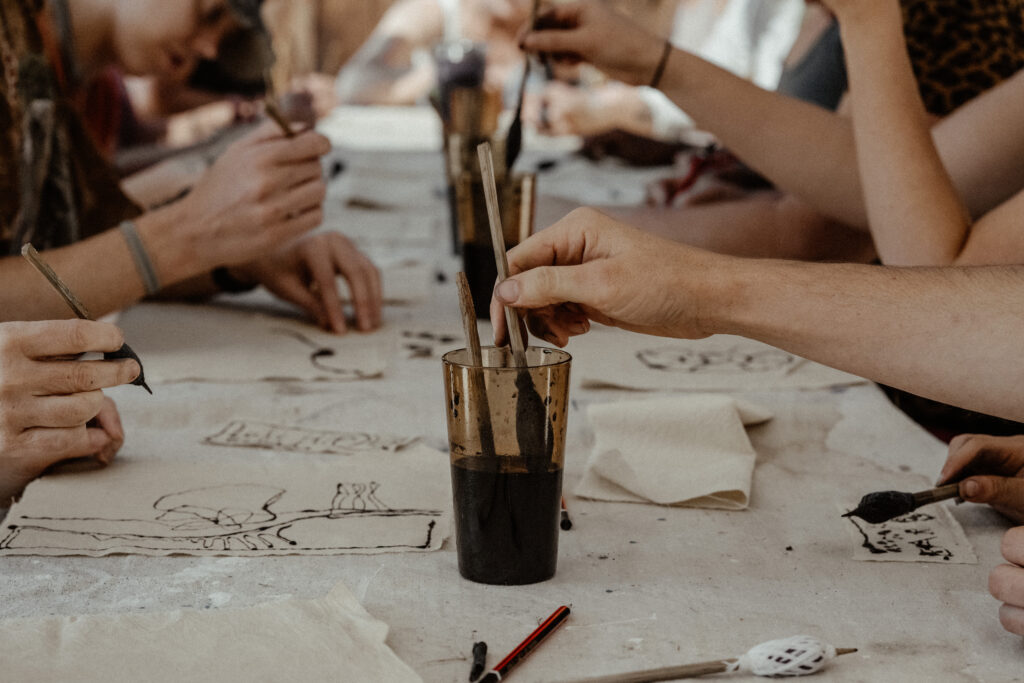
The workshops created an intergenerational community, particularly meaningful for younger participants like Yendapalli. Meeting people from various age groups was one of her favorite aspects of the workshop.
Shah’s holistic approach to storytelling, community, and craft resonated deeply with participants. For Prasad, who had always struggled with perfectionism in creative settings, the supportive environment was revelatory.
“It’s an insecurity of mine: I always feel like I strive for this perfection,” she explained. “And I think classes would sort of intimidate me with other people because I would be at a different skill level, and I feel a little intimidated about what my work looked like.”
“I never felt that intimidation in this space, at that workshop,” Prasad said.
Her final piece is a reflection of the workshop’s philosophy. “I was just trying to think of something I was doing in that moment. And I had just built a planter box to keep outside of my window,” she said.
Split into five boxes, the piece tells a dual story of Prasad’s journey with kalamkari through the lifecycle of a strawberry seed. It ends at center, with a free-drawn kalamkari caricature of herself reaching for ripe, plump fruit.
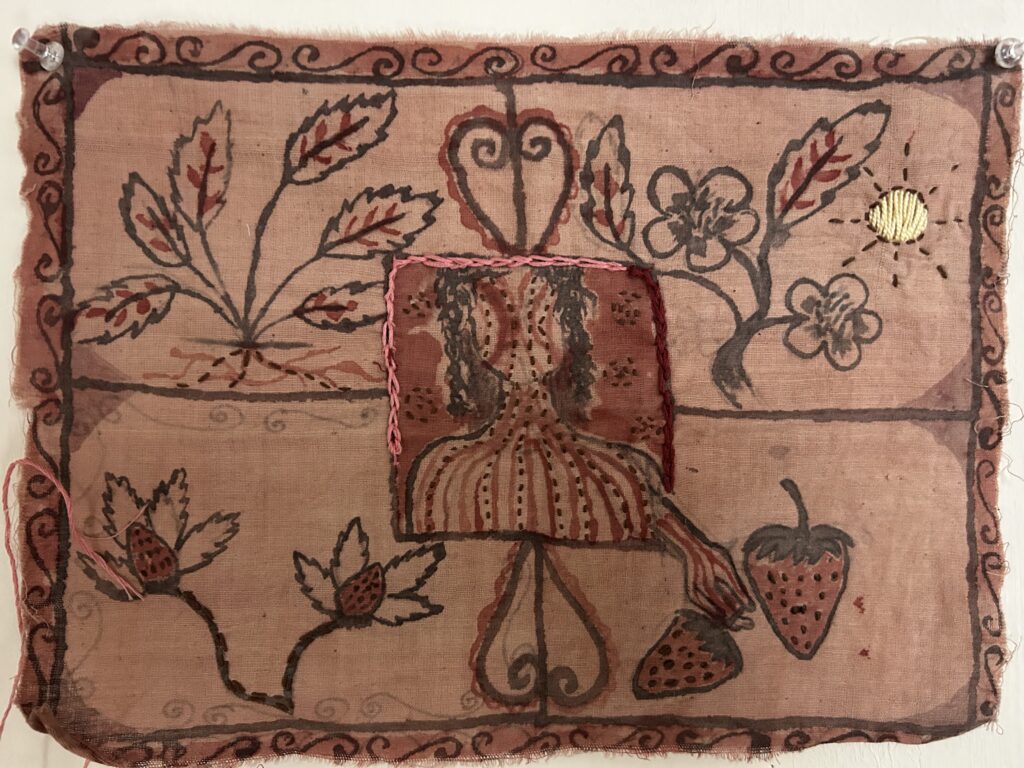
The paradox of distance
Yendapalli travelled to India to visit her family; and while working on a school assignment, interacted with kalamkari designers and artisans in Hyderabad, the largest city in the state of Telangana. “There was a difference in the way that kalamkari was perceived,” she said. “In New York, people are willing to have the appetite, to appreciate and to see the meaning behind it.” In contrast, Yendapalli found that some people viewed this approach as artificial or indulgent. “They weren’t willing to kind of see the deeper meanings of it,” she said.
Commercial pressures have moved many traditional kalamkari producers away from the craft’s origins in storytelling and archiving, with focus on fashion and apparel products that will generate revenue. Most kalamkari work that exists in India, Shah notes, drawing on her independent archival research with the Metropolitan Museum of Art and her time in the industry, exists in sarees, dresses, shirts and other garments.
For those in the diaspora, there is privilege in being removed from economic pressures, coupled with the relaxed atmosphere Shah sought to create in her workshops, that makes practicing kalamkari in its traditional vein more viable than for artisans in India.
The irony isn’t lost on Yendapalli, that she, while living thousands of miles away from kalamkari’s birthplace, may be among few people observing its foundational practices. “Kalamkari, even as a practice, it’s written more than it is painted,” Yendapalli explained. “It is very much like a form of storytelling or archiving one’s history.”
Beyond preservation
As traditional artisans age out of the craft in India, diasporic practitioners like Shah are playing an unexpected role in preservation — not just maintaining techniques but adapting them for new contexts and communities. In Brooklyn apartments and community centers, in the hands of young professionals and students, the ancient art of kalamkari continues to evolve, carrying forward not just techniques but the deeper wisdom of slow-making, community connection, and the radical act of creating beauty in an accelerated world.
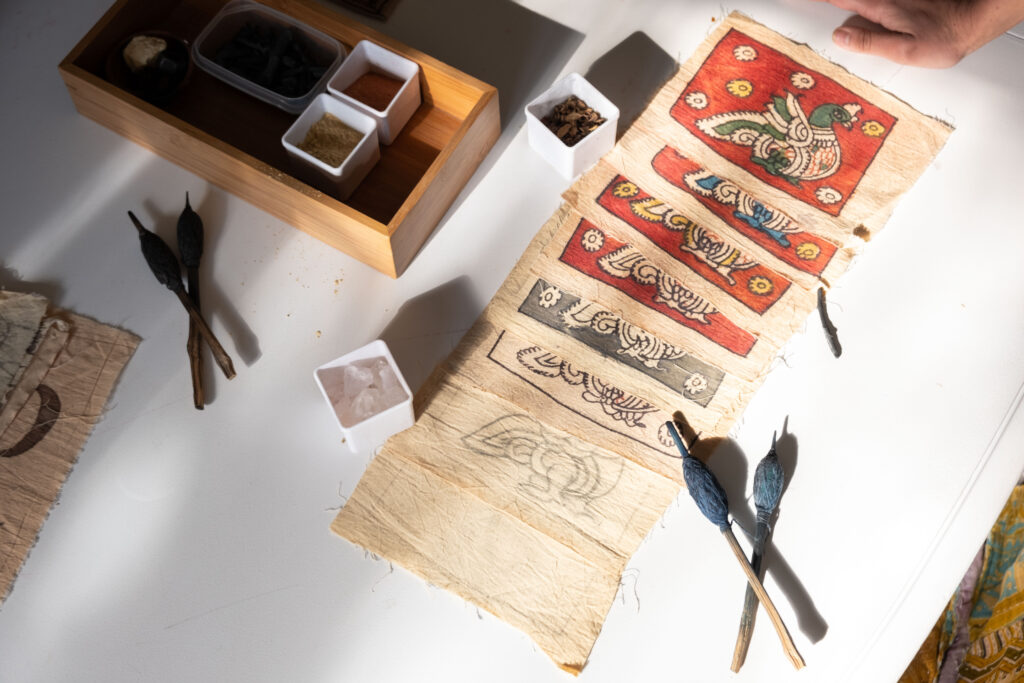

New York University
Seattle 2025





Apply
Become a fellow or editor
Donate
Support our impact
Partner
Work with us as a brand

The Asian American Journalists Association (AAJA) is a membership nonprofit advancing diversity in newsrooms and ensuring fair and accurate coverage of communities of color. AAJA has more than 1,500 members across the United States and Asia.